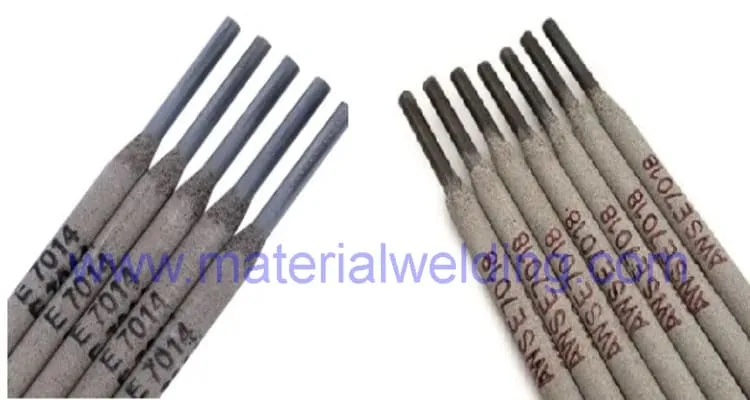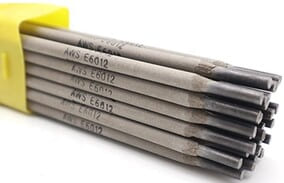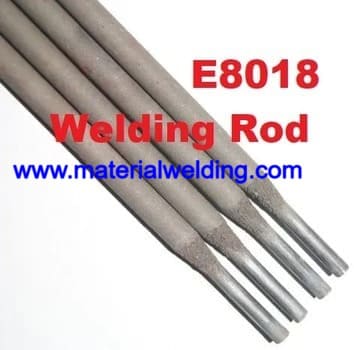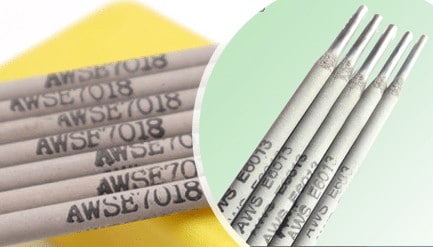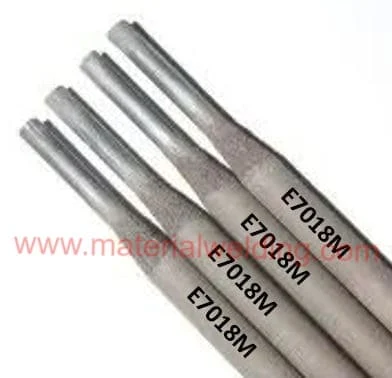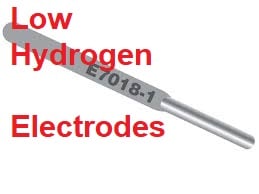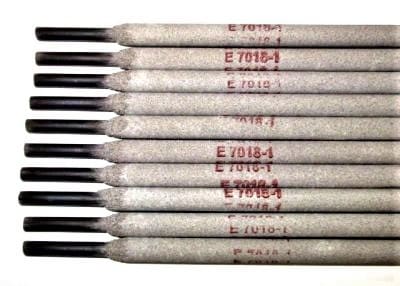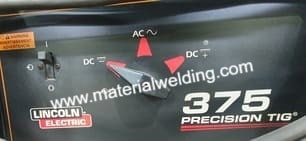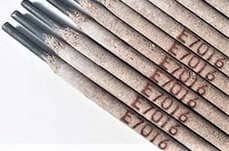E7018 vs E7018-1 vs E6013 vs E7016 vs E6011
This posts cover comparison of E7018 vs E7018-1 vs E6013 vs E7016 vs E6011 & all other common but important welding rods.
E7018 and E7018-1 are both carbon steel electrodes except the main difference of higher toughness properties of weld made with E7018-1. Other than that E7018-1 contains higher manganese compared to E7018 welding rod.
A summary of E7018 vs E7018-1 and main differences between these two welding rods are:
| Rod Characteristics | E7018 | E7018-1 |
|---|---|---|
| AWS Specification | AWS A5.1 | AWS A5.1 |
| Classification | E7018 | E7018-1 |
| Weld toughness | 20 ft·lbf at -20°F (27 J at –30°C) | 20 ft·lbf at –50°F (27 J at –45°C) |
| Manganese Level | 1.60% Maximum | 1.60% Maximum |
| Polarity | AC, DCEP | AC, DCEP |
| Welding Position | All | All |
| Weld penetration | Medium | Medium |
| Coating type | Basic Iron Powder | Basic Iron Powder |
| Arc features | Smooth | Smooth |
| Application | Fillet, fill & cap passes | Fillet, Fill & cap passes |
Read More: Read more: Everything you need to know about E7018-1 Welding Rod.
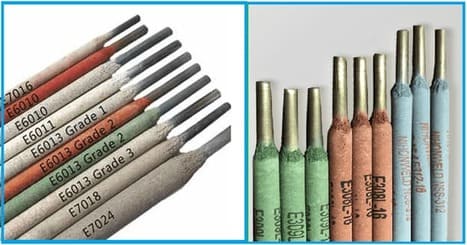
E7018 vs E6010
E6010 is a high cellulose covering type welding rod used for open root run welding in pipes. There is no slag with E6010 rod due to its pulp base coating.
The main difference between E7018 and R6010 are covering type, weld deposit tensile & yield strength, toughness and welding polarity. The table below covers all differences between E6010 vs. E7018 Welding rod.
| Rod Characteristics | E7018 | E6010 |
|---|---|---|
| AWS Specification | AWS A5.1 | AWS A5.1 |
| Classification | E7018 | E6010 |
| Coating types | Low hydrogen Potassium with added Iron Powder | High Cellulose Sodium |
| Tensile & Yield Strength (Ksi) | 70 & 58 | 60 & 48 |
| Polarity | AC, DCEP | DCEP only |
| Welding Position | All | All |
| Weld penetration | Medium | Deep |
| Slag | Thick slag |
thin, fragile slag |
| Arc features | Smooth arc | High Force spray arc |
| Application | Fillet, fill & cap passes | Root & hot pass, welding on rusty, dirty, painted surface |
Read more: Everything you need to know about E6010 Welding Rod.
E7018 vs E6011
E6011 is a High Cellulose Covering welding rod like E6010 but E6011 can be used with AC & DCEP Polarity (E6010 only for DCEP). E6011 covering is made of Sodium and potassium.
| Rod Characteristics | E7018 | E6011 |
|---|---|---|
| AWS Specification | AWS A5.1 | AWS A5.1 |
| Classification | E7018 | E6011 |
| Coating types | Low hydrogen Potassium with added Iron Powder | High Cellulose Sodium & Potassium |
| Tensile & Yield Strength (Ksi) | 70 & 58 | 60 & 48 |
| Polarity | AC, DCEP | AC, DCEP only |
| Welding Position | All | All |
| Weld penetration | Medium | Deep |
| Slag | Thick slag |
Light, fragile slag |
| Arc features | Smooth arc | Force spray arc |
| Application | Fillet, fill & cap passes | Root & hot pass, welding on rusty, dirty, painted surface |
Read more: Everything you need to know about E6011 Welding Rod.
E7018 vs E6012
E6012 is mild steel welding rod having covering made of high titania sodium while E7018 welding rod coating is made of low hydrogen potassium. The main differences between E7018 and E6012 are listed below:
| Rod Characteristics | E7018 | E6012 |
|---|---|---|
| AWS Specification | AWS A5.1 | AWS A5.1 |
| Classification | E7018 | E6012 |
| Coating types | Low hydrogen Potassium with added Iron Powder | High titania sodium |
| Tensile & Yield Strength (Ksi) | 70 & 58 | 60 & 48 |
| Polarity | AC, DCEP | AC, DCEN only |
| Welding Position | All | All |
| Weld penetration | Medium | Low penetration |
| Slag | Thick slag |
Dense slag |
| Arc features | Smooth arc | stable arc |
| Application | Fillet, fill & cap passes | large single pass Fillet weld, gap bridging & cap passes |
E7018 vs E6013
E6013 is the best welding rod for sheet metal, structural welding and thin material welding applications. The covering of made of high titania potassium while E7018 coating is low hydrogen potassium.
The main differences between E7018 and E6013 are listed below:
| Rod Characteristics | E7018 | E6013 |
|---|---|---|
| AWS Specification | AWS A5.1 | AWS A5.1 |
| Classification | E7018 | E6013 |
| Coating types | Low hydrogen Potassium with added Iron Powder | High titania potassium |
| Tensile & Yield Strength (Ksi) | 70 & 58 | 60 & 48 |
| Polarity | AC, DCEP | AC, DCEN & DCEP |
| Welding Position | All | All |
| Weld penetration | Medium | low |
| Slag | Thick slag |
light & easily removable |
| Arc features | Smooth arc | stable smooth arc |
| Application | Fillet, fill & cap passes | best for sheet metal welding |
E7018 vs E7014
| Rod Characteristics | E7018 | E7014 |
|---|---|---|
| AWS Specification | AWS A5.1 | AWS A5.1 |
| Classification | E7018 | E7014 |
| Coating types | Low hydrogen Potassium with added Iron Powder | Iron Powder titania |
| Tensile & Yield Strength (Ksi) | 70 & 58 | 70 & 58 |
| Polarity | AC, DCEP | AC, DCEN & DCEP |
| Welding Position | All | All |
| Weld penetration | Medium | Low to Medium |
| Slag | Thick slag |
Medium, very easily removable slag |
| Arc features | Smooth arc | smooth, quiet arc |
| Application | Fillet, fill & cap passes | high deposition applications |
E7018 vs E7015
E7015 is a low hydrogen sodium covering base electrode used with DCEP polarity. It is used for making small welds on thick materials, welding high-sulfur and enameling steels.
While E7018 coating is low hydrogen potassium, E7015 covering is low hydrogen sodium. E7018 can be used with AC & DCEP while E7015 can be used only with DCEP current.
| Rod Characteristics | E7018 | E7015 |
|---|---|---|
| AWS Specification | AWS A5.1 | AWS A5.1 |
| Classification | E7018 | E7015 |
| Coating types | Low hydrogen Potassium with added Iron Powder | Low-hydrogen sodium |
| Tensile & Yield Strength (Ksi) | 70 & 58 | 70 & 58 |
| Polarity | AC, DCEP | DCEP only |
| Welding Position | All | All |
| Weld penetration | Medium | Moderately |
| Slag | Thick slag |
heavy, friable, easily removable slag |
| Arc features | Smooth arc | Moderately smooth arc |
| Application | Fillet, fill & cap passes | welding high-sulfur and enameling steels |
E7018 vs E7016
E7016 is similar to E7015 except the difference in the coating which is similar to R7018 but except no-added iron powder in it.
| Rod Characteristics | E7018 | E7016 |
|---|---|---|
| AWS Specification | AWS A5.1 | AWS A5.1 |
| Classification | E7018 | E7016 |
| Coating types | Low hydrogen Potassium with added Iron Powder | Low-hydrogen potassium |
| Tensile & Yield Strength (Ksi) | 70 & 58 | 70 & 58 |
| Polarity | AC, DCEP | AC, DCEP |
| Welding Position | All | All |
| Weld penetration | Medium | Moderately |
| Slag | Thick slag |
heavy, friable, easily removable slag |
| Arc features | Smooth arc | Moderately smooth arc |
| Application | Fillet, fill & cap passes | welding high-sulfur and enameling steels |
E7018 vs E8018
E8018 is a welding rod as per AWS A5.5 for low alloy steel welding while E7018 is as per AWS A5.1 for mild steel and carbon steel welding.
E8018-XX has -XX supplement classification to cover wide range of low-alloy welding electrodes. Example of such rod are: E8018-B2 ( for Cr-Mo steel), E8018-C1 (For Nickel Steel), E8018-D2 (For Mn-Mo Steel), etc.
There is no electrode only having classification as E8018 is available.
E7018 vs ER70S-6
E7018 and ER70S-6 are both having same weld deposit mechanical (tensile, yield & toughness) properties and chemical composition.
The main difference is type of welding process they are used- E7018 is for Stick Welding (SMAW) while ER70S-6 is used for MIG-MAG (GMAW) & TIG welding.
An external welding shielding gas is required for ER70S-6 welding while with E7018 no external shielding gas is needed.
